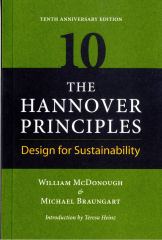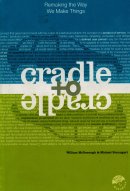 Era il 1992 quando la città di Hannover, che si preparava ad organizzare l’EXPO del 2000, commissionò a William McDonough e Michael Braungart un insieme di istruzioni relative alla progettazione di edifici e oggetti con attenzione alla tutela dell’ambiente, il loro effetto sullo sviluppo sostenibile e il loro impatto complessivo sulla società. Nascevano così i 9 ‘princìpi di Hannover’. Con una società ormai rassegnata a dare per scontata comunque una certa quota di danno ambientale e ripiegata a discuterne l’ammontare tollerabile per legge, Bill McDonough e Michael Braungart invitarono per la prima volta l’opinione pubblica a considerare un’alternativa. Semplicemente, perché non progettare prodotti e istituzioni in grado di sostenere l’ambiente, invece di danneggiarlo?
Era il 1992 quando la città di Hannover, che si preparava ad organizzare l’EXPO del 2000, commissionò a William McDonough e Michael Braungart un insieme di istruzioni relative alla progettazione di edifici e oggetti con attenzione alla tutela dell’ambiente, il loro effetto sullo sviluppo sostenibile e il loro impatto complessivo sulla società. Nascevano così i 9 ‘princìpi di Hannover’. Con una società ormai rassegnata a dare per scontata comunque una certa quota di danno ambientale e ripiegata a discuterne l’ammontare tollerabile per legge, Bill McDonough e Michael Braungart invitarono per la prima volta l’opinione pubblica a considerare un’alternativa. Semplicemente, perché non progettare prodotti e istituzioni in grado di sostenere l’ambiente, invece di danneggiarlo?
 Design for Sustainability: Designing for sustainability requires awareness of the full short and long-term consequences of any transformation of the environment. Sustainable design is the conception and realization of environmentally sensitive and responsible expression as a part of the evolving matrix of nature. I principi di Hannover furono la prima espressione di quell’idea rivoluzionaria. In quelle 9 snelle dichiarazioni vengono costituiti allo stesso tempo un sistema di valori e una metodologia di progettazione che poi si ritroveranno ancora nel testo Cradle to Cradle: Remaking the Way We Make Things e nel sistema di certificazione omonimo. Eccoli, i 9 Hannover Principles.
Design for Sustainability: Designing for sustainability requires awareness of the full short and long-term consequences of any transformation of the environment. Sustainable design is the conception and realization of environmentally sensitive and responsible expression as a part of the evolving matrix of nature. I principi di Hannover furono la prima espressione di quell’idea rivoluzionaria. In quelle 9 snelle dichiarazioni vengono costituiti allo stesso tempo un sistema di valori e una metodologia di progettazione che poi si ritroveranno ancora nel testo Cradle to Cradle: Remaking the Way We Make Things e nel sistema di certificazione omonimo. Eccoli, i 9 Hannover Principles.
The Hannover Principles
-
Insist on rights of humanity and nature to co-exist in a healthy, supportive, diverse and sustainable condition.
-
Recognize interdependence. The elements of human design interact with and depend upon the natural world, with broad and diverse implications at every scale. Expand design considerations to recognizing even distant effects.
-
Respect relationships between spirit and matter. Consider all aspects of human settlement including community, dwelling, industry and trade in terms of existing and evolving connections between spiritual and material consciousness.
-
Accept responsibility for the consequences of design decisions upon human well-being, the viability of natural systems and their right to co-exist.
-
Create safe objects of long-term value. Do not burden future generations with requirements for maintenance or vigilant administration of potential danger due to the careless creation of products, processes or standards.
-
Eliminate the concept of waste. Evaluate and optimize the full life-cycle of products and processes, to approach the state of natural systems, in which there is no waste.
-
Rely on natural energy flows. Human designs should, like the living world, derive their creative forces from perpetual solar income. Incorporate this energy efficiently and safely for responsible use.
-
Understand the limitations of design. No human creation lasts forever and design does not solve all problems. Those who create and plan should practice humility in the face of nature. Treat nature as a model and mentor, not as an inconvenience to be evaded or controlled.
-
Seek constant improvement by the sharing of knowledge. Encourage direct and open communication between colleagues, patrons, manufacturers and users to link long term sustainable considerations with ethical responsibility, and re-establish the integral relationship between natural processes and human activity.
The Hannover Principles should be seen as a living document committed to the transformation and growth in the understanding of our interdependence with nature, so that they may adapt as our knowledge of the world evolves. [1992 © W. McDonough & M. Braungart].
 William Andrews McDonough is an American designer, advisor, author, and thought leader. McDonough is founding principal of William McDonough + Partners, co-founder of McDonough Braungart Design Chemistry (MBDC) with German chemist Michael Braungart as well as co-author of Cradle to Cradle: Remaking the Way We Make Things and The Upcycle: Beyond Sustainability—Designing for Abundance, also with Braungart. McDonough’s career is focused creating a beneficial footprint. He espouses a message that we can design materials, systems, companies, products, buildings, and communities that continuously improve over time.
William Andrews McDonough is an American designer, advisor, author, and thought leader. McDonough is founding principal of William McDonough + Partners, co-founder of McDonough Braungart Design Chemistry (MBDC) with German chemist Michael Braungart as well as co-author of Cradle to Cradle: Remaking the Way We Make Things and The Upcycle: Beyond Sustainability—Designing for Abundance, also with Braungart. McDonough’s career is focused creating a beneficial footprint. He espouses a message that we can design materials, systems, companies, products, buildings, and communities that continuously improve over time.
 Michael Braungart is a German chemist who advocates that humans can make a positive instead of a negative environmental impact by redesigning industrial production and therefor that dissipation is not waste. A former Greenpeace activist who once lived in a tree as protest, he is now considered to be a visionary environmental thinker. Founder of EPEA International Umweltforschung GmbH in Hamburg, Germany, and co-founder of MBDC, Dr. Braungart is currently a professor of Process Engineering at the University of Applied Sciences in Suderburg, also serving as director of an interdisciplinary materials flow management masters program. He currently holds the Cradle-to-Cradle chair at the Erasmus University Rotterdam, the Netherlands. [Source: Wikipedia].
Michael Braungart is a German chemist who advocates that humans can make a positive instead of a negative environmental impact by redesigning industrial production and therefor that dissipation is not waste. A former Greenpeace activist who once lived in a tree as protest, he is now considered to be a visionary environmental thinker. Founder of EPEA International Umweltforschung GmbH in Hamburg, Germany, and co-founder of MBDC, Dr. Braungart is currently a professor of Process Engineering at the University of Applied Sciences in Suderburg, also serving as director of an interdisciplinary materials flow management masters program. He currently holds the Cradle-to-Cradle chair at the Erasmus University Rotterdam, the Netherlands. [Source: Wikipedia].

2 thoughts on “The Hannover Principles. Design for Sustainability.”